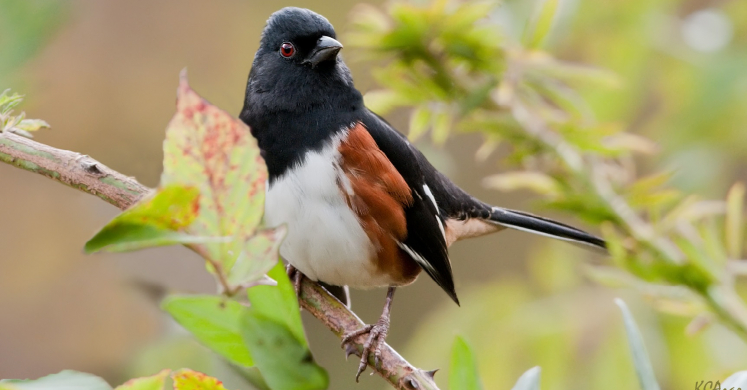Blog

#bioPGH: Eastern Towhees
 A resource of Biophilia: Pittsburgh, #bioPGH is a weekly blog and social media series that aims to encourage both children and adults to reconnect with nature and enjoy what each of our distinctive seasons has to offer.
A resource of Biophilia: Pittsburgh, #bioPGH is a weekly blog and social media series that aims to encourage both children and adults to reconnect with nature and enjoy what each of our distinctive seasons has to offer.
It’s happened the last several mornings now – I’m sitting on my back porch with my coffee, but I keep hearing a little bird calling that I should be partaking in something else: Drink-your-teeeea, drink-your-teeeea.
Well, perhaps the Eastern Towhee (Pipilo erythrophthalmus) isn’t exactly telling me to switch my morning beverage routine, but their song is easily recognized by the handy mnemonic “drink your tea.” Besides a song reminiscent of brews, towhees also have a few different calls, one of which inspired their name “towhee.” In the clip below, you can hear their variations on their call at the 32-second and 45-second marks, and their “drink your tea” song at 38 seconds.
Towhees are a large member of the American sparrow family (Passerellidae) along with juncos, sparrows, brushfinch, and tanagers. Our Eastern Towhees have black backs and heads, rusty-rufous (reddish-brown) sides, a white belly, and red eyes; but they do have a Floridian counterpart with white eyes. They also have a Western look-alike, the Spotted Towhee (Pipilo maculatus). These two species probably used to a single species before one of the last glacial periods when they were physically separated for an extended period of time (as a fun aside, that process of new species arising because of a physical, geographic barrier split a population into two is called allopatric speciation.)
Given the habitat around my house, it’s no wonder we often hear towhees. They prefer brushy, shrubby habitats or open and newer growth woods, rather than close forest interiors. The habitat in my backyard is a blend of shrubs and trees before opening up to a larger lawn, but the towhees seem quite content with the vegetation that grows between the oaks, walnut, and maple behind my yard. Since they are ground nesters, shrub vegetation makes a reasonable cover. The area just beyond my backyard, with its black raspberry thickets, also seems to provide a veritable buffet for omnivores like our Eastern Towhees, particularly given that they rely on a blend of fruits, nuts, seeds, insects, spiders, leaves, and even acorns.
Though Eastern Towhees are not currently under any great conservation concerns, they do face possible habitat loss through unchecked climate change. The Audubon Society created Climate Vulnerability assessments for different species given their biological needs and habitat types, and towhees, like most other birds, stand to lose quite a bit if the planet continues to warm. The good news is it doesn’t have to! Climate change is happening because of has produced an excess of carbon dioxide and other greenhouse gases in the atmosphere; we can help by reducing that. Check out Phipps’ Easy Steps for Big Impact for Climate Change and keep learning about climate change through reputable sources like NASA and NOAA. If we could accidentally create the problem, we can work together to fix it!
Connecting to the Outdoors Tip: If you have never seen a towhee in your area, check out eBird for the latest recorded sightings!
Continue the Conversation: Share your nature discoveries with our community by posting to Twitter and Instagram with hashtag #bioPGH, and R.S.V.P. to attend our next Biophilia: Pittsburgh meeting.
Resources
Cornell Lab of Ornithology – Eastern Towhees
Audubon Society – Eastern Towhees
Photo credits: Cover, Kelly Cogan Azar, CC BY-ND 2.0; Header, Pexels CC0
